Kym Green Bush
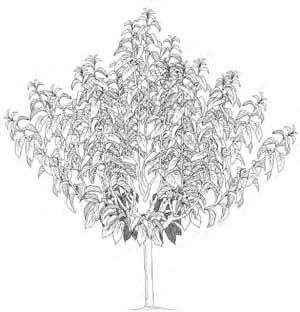
Kym Green Bush (All illustrations below are from the publication Cherry Training Systems)
The Kym Green Bush (KGB) is the only system of the eight that creates a fully pedestrian orchard—one that can be harvested without ladders or platforms. Tree formation is easy and requires minimal labor; mature pruning is simple and follows a repeatable plan.
Although most varieties grow and produce well with a KGB system, it is not recommended for non-spur type varieties such as Regina and Attika, which produce a significant proportion of fruit at the base of 1-year-old shoots. This wood is eliminated in the KGB system.
Spanish Bush

Spanish Bush System
The establishment years of the KGB system are similar to the Spanish bush. But once the structure is formed, the two systems diverge.
In a Spanish bush tree, all upright leaders are permanent and fruit is produced on small laterals that are renewed regularly. In a KGB tree, all vertical leaders eventually are renewed and the only permanent wood is the lower framework of the tree. The KGB uses vigorous or semi-vigorous rootstocks.
Growers can choose the number of vertical leaders to moderate the tree vigor.
Both Spanish bush and KGB are freestanding and require no trellis. They need spacing of 6 to 8 feet between trees and 14 to 18 feet between rows.
Steep Leader
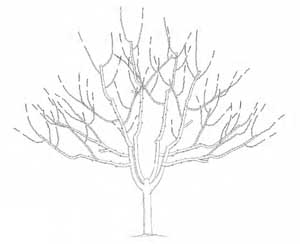
Steep Leader
The steep leader training system was developed by growers in Washington State.
Three or four vertical leaders emerge from the base of the tree and horizontal scaffold branches develop from them.
Fruiting occurs on temporary lateral branches that grow from the vertical leaders and horizontal scaffolds. Each leader mimics a one-sided spindle tree.
The trees are quite vigorous—so spacing needs to be 10 to 16 feet between trees, depending on the rootstock, and 14 to 18 feet between rows.
Super Slender Axe
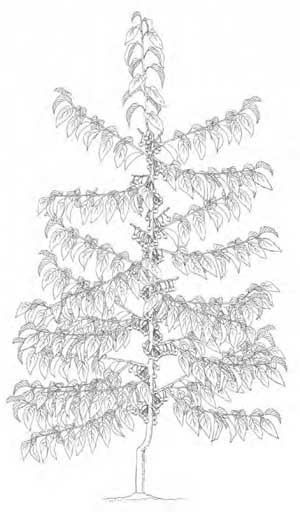
Super Slender Axe
Also called the super spindle axe, the super slender axe was developed as a modification of the spindle to gain greater control of tree growth.
The system requires a trellis to support the trees, which have a small trunk diameter and are planted 20 to 40 inches apart in rows 10 to 11.5 feet apart.
The super slender axe system needs dwarfing and precocious rootstocks such as Gisela 5 and Gisela 3. In the case of low vigor sites or self-fertile varieties, it may be possible to use more vigorous, precocious rootstocks, such as Gisela 6 or Gisela 12.
Varieties with good vigor, upright growth habits, and the ability to produce lateral shoots are preferred. The most important variety characteristic is the capacity to produce fruit on basal buds of one-year-old shoots.
The production habit of this system is significantly different from other systems. Instead of producing fruit on spurs with multiple small flower buds, it utilizes the solitary large flower buds at the base of one-year-old shoots.
This results in a favorable fruit-to-leaf ratio that yields good fruit size and quality. The low production capacity per tree is compensated for by the high planting density.
Tall Spindle Axe
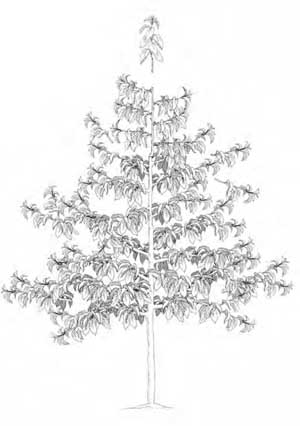
Tall Spindle Axe
The tall spindle axe tree canopy takes advantage of the sweet cherry tree’s natural tendency to develop a central leader.
However, this system modifies the natural branching habit, replacing annual tiers of four to five strong lateral branches with a continuously spiraled whorl of moderately vigorous lateral branches, preferably forming about 10 or more per year during canopy development, to ultimately form a conical “Christmas tree” shape.
The system is further differentiated by two key concepts:
—Annual heading of lateral shoots to balance leaf-to-fruit ratios and future crop loads;
—Annual renewal of the oldest fruiting branches so that the only permanent structure is the central leader.
The tall spindle axe is a training system well-suited for dwarfing to semi-vigorous rootstocks, or vigorous rootstocks on weak soils, since growth is comprised primarily of lateral shoots of moderate vigor borne on a single vertical leader.
Spacing is 5 to 8 feet between trees and 11 to 14 feet between rows.
Upright Fruiting Offshoots
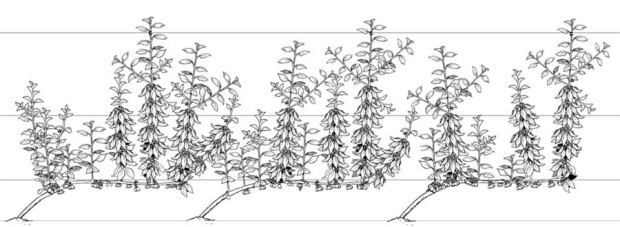
Upright Fruiting Offshoots (UFO)
The Upright Fruiting Offshoots (UFO) system was developed to simplify training, pruning, and crop load management; use the sweet cherry’s natural upright growth habit and manage vigor by establishing multiple vertical structural fruiting units (number of vertical units should be proportional to tree vigor); optimize input efficiencies (e.g., light, labor, agrochemicals) and achieve high, uniform light distribution to fruiting sites; and facilitate the adoption of orchard mechanization and automation technologies.
At maturity, the UFO system yields a planar fruiting wall architecture that is precocious, productive, and simple to maintain.
Each tree comprises a permanent single horizontal trunk (or cordon) from which renewable fruiting leaders grow vertically. Fruit are borne predominantly on spurs but also at the base of 1-year-old shoots, all on vertical wood.
The UFO system may be configured to a single vertical wall or dual-angled Y system (with each plane 30 degrees off vertical).
Both require trellising (about five wires per plane). UFO training may be used to establish a pedestrian orchard, though higher yields in the single vertical wall can be achieved by maintaining a tree height about 20 percent taller than the between-row spacing.
Establishing the UFO system is straightforward with little to no pruning required at planting. It can be planted on various rootstocks and spacings.
Vogel Central Leader

Vogel Central Leader
The Vogel central leader system requires little establishment pruning because it takes advantage of the inherent central leader nature of the young cherry tree.
Minimal pruning, a modest growth rate due to dwarfing or semi-dwarfing rootstocks, minimal fertilization during establishment, and an intermediate planting density result in relatively high early yields.
Without additional manipulation, a vigorous rootstock will produce a very tall tree on this system.
The “Christmas tree” shape promotes good light distribution throughout the canopy, and fruiting wood is renewed on a regular basis with this system.
Spacing can be 6 to 9 feet in the row and 13 to 16 feet between rows.






[…] goodfruit.com/the-seven-cherry-training-systems […]
Fruit Pole
Year 1. As the dormant bud grows, remove all of the new laterals, thus form a fruit pole.
Year 2. Fruit can be harvested at the base of fruit pole. NOTE.many laterals will grow horizontal from the fruit pole, allow to grow.
Year 3. Allow the extension growth at the end of the previous season growth until winter. Then leaf scar prune. (Cut through the leaf scar, and at this time cut through the bud cluster to reduce fruit loading?
NEVER CUT THROUGH THE FIRST SEASONS WOOD
Pruning
1. Thin out new seson growth. 4 lateral remove 2, 2 laterals remove 1.
The tree vigour lateral extention growth grows through the bud cluster giving more leaf for the fruit to size.
Water every week from harvest to terminal bud development.
Results
1. A balanced fruit pole.
2. 5mm increase in crop size.
Hello
Can I use the ufo training system with sweet cherries like kordia,burlat and sammit on g6 rootstocks